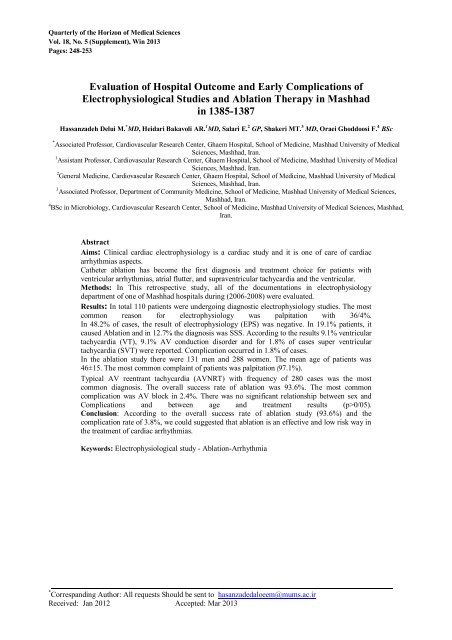Ø¨Ø±Ø±Ø³Û ÙتاÙج ٠عÙارض زÙدرس ٠طاÙعات اÙکترÙÙÙزÙÙÙÙÚÙÚ© ٠در٠ا٠با ...
Ø¨Ø±Ø±Ø³Û ÙتاÙج ٠عÙارض زÙدرس ٠طاÙعات اÙکترÙÙÙزÙÙÙÙÚÙÚ© ٠در٠ا٠با ...
Ø¨Ø±Ø±Ø³Û ÙتاÙج ٠عÙارض زÙدرس ٠طاÙعات اÙکترÙÙÙزÙÙÙÙÚÙÚ© ٠در٠ا٠با ...
Create successful ePaper yourself
Turn your PDF publications into a flip-book with our unique Google optimized e-Paper software.
Quarterly of the Horizon of Medical SciencesVol. 18, No. 5 (Supplement), Win 2013Pages: 248-253Evaluation of Hospital Outcome and Early Complications ofElectrophysiological Studies and Ablation Therapy in Mashhadin 1385-1387Hassanzadeh Delui M. * MD, Heidari Bakavoli AR. 1 MD, Salari E. 2 GP, Shakeri MT. 3 MD, Oraei Ghoddoosi F. 4 BSc* Associated Professor, Cardiovascular Research Center, Ghaem Hospital, School of Medicine, Mashhad University of MedicalSciences, Mashhad, Iran.1 Assistant Professor, Cardiovascular Research Center, Ghaem Hospital, School of Medicine, Mashhad University of MedicalSciences, Mashhad, Iran.2 General Medicine, Cardiovascular Research Center, Ghaem Hospital, School of Medicine, Mashhad University of MedicalSciences, Mashhad, Iran.3 Associated Professor, Department of Community Medicine, School of Medicine, Mashhad University of Medical Sciences,Mashhad, Iran.4 BSc in Microbiology, Cardiovascular Research Center, School of Medicine, Mashhad University of Medical Sciences, Mashhad,Iran.AbstractAims: Clinical cardiac electrophysiology is a cardiac study and it is one of care of cardiacarrhythmias aspects.Catheter ablation has become the first diagnosis and treatment choice for patients withventricular arrhythmias, atrial flutter, and supraventricular tachycardia and the ventricular.Methods: In This retrospective study, all of the documentations in electrophysiologydepartment of one of Mashhad hospitals during (2006-2008) were evaluated.Results: In total 110 patients were undergoing diagnostic electrophysiology studies. The mostcommon reason for electrophysiology was palpitation with 36/4%.In 48.2% of cases, the result of electrophysiology (EPS) was negative. In 19.1% patients, itcaused Ablation and in 12.7% the diagnosis was SSS. According to the results 9.1% ventriculartachycardia (VT), 9.1% AV conduction disorder and for 1.8% of cases super ventriculartachycardia (SVT) were reported. Complication occurred in 1.8% of cases.In the ablation study there were 131 men and 288 women. The mean age of patients was46±15. The most common complaint of patients was palpitation (97.1%).Typical AV reentrant tachycardia (AVNRT) with frequency of 280 cases was the mostcommon diagnosis. The overall success rate of ablation was 93.6%. The most commoncomplication was AV block in 2.4%. There was no significant relationship between sex andComplications and between age and treatment results (p>0/05).Conclusion: According to the overall success rate of ablation study (93.6%) and thecomplication rate of 3.8%, we could suggested that ablation is an effective and low risk way inthe treatment of cardiac arrhythmias.Keywords: Electrophysiological study - Ablation-Arrhythmia* Correspanding Author: All requests Should be sent to hasanzadedaloeem@mums.ac.irReceived: Jan 2012 Accepted: Mar 2013
بررسی نتایج و عوارض زودرس مطالعات الکتروفیزیولوژیک و درمان با ابلیشن 253tachycardia in adult patients.Electrophysiologicalcharacteristic‚pharmacologicalresponse‚possible mechanism‚and effects ofradiofrequency ablation. Circul 1994; 90(3):1262-1278.17. Lickfett L, Remerie S, Mittmann-Braun E,Nickenig G. Outcome of atrial fibrillationablation: assessmenf of success. Minervacardioangiol 2008; 56(6): 635-641.18. Kohno T‚ Ihara K‚ Sugesawa K‚ Fukada Y‚Miura H‚ Maesako N‚ et al. Factor ofsuccessful radiofrequency catheter ablation tothe slow pathway in patients with uncommonatrioventricular nodal reentrant tachycardia.Rinsho Byori 2003; 51(4): 300-305._________________________________________________adolescents. Progpediatr Cardiol 2001; 13(1):53-60.6. Mickelsen S, Dudley B, Treat E, Barela G,Omdahl J, Ku Sumoto F. Survey of physicianexperience, trends and out comes with atrialfibrillation ablation. Jinterv CardElectrophysiol 2005; 12 (3): 213-220.7. Hebe J. Role of catheter and surgicalablation in congenital heart disease. cardiol clin2002; 20(3): 469-486.8. Josephon ME‚ Zimethaun P. Thetachyarrhythmias. In: Kasper DL‚ Fauci AS‚Braunwald E‚ Hauser S‚ Jameson JL‚ editors.Harrison’s principles of internal medicine. 16 thed. New York: McGraw Hill; 2005; 3: 1342-1358.9. Philip J Podrid. Invasive cardiacelectrophysiology studies: tachyarrhythmias.[homepage on the internet]. c2003 [update 2003August 18; cited 2011 May 8].10. Philip J Podrid‚ Leonard I Ganz. Overviewof invasive cardiac electrophysiology studies.[homepage on the internet]. c2008 [update 2008Septenber 26; cited 2011 May 8]. Availablefrom: http://www.uptodate.com/contents/overview of invasive cardiac electrophysiologystudies11. Mc Gavigan AD‚ Rae AP‚ Cobbe SM‚Rankin AC. Junctional rhythm-a suitablesurrogate endpoint in catheter ablation ofatrioventricular nodal reentry tachycardia?Pacing Clin Electrophysio l200; 28(9): 1052-1054.12. Fogaros RN. Catheter ablation. In: FogarosRN. Electrophysiologic testing, 3 rd ed. Tehran:Mirmah; 1998: 184-210.13. Leonard I Ganz. Catheter ablation ofcardiac arrhythmias: over view and technicalaspects. [homepage on the internet]. c2003[update 2010 Jul 27; cited 2011 May 8].Availablefrom:http://www.uptodate.com/contents/ catheterablation of cardiac arrhythmias: over view andtechnical aspects14. Apiyasawat S‚ Prasertwitayakij N‚Ngarmukos T‚ Chandanamattha P‚Likittanasombat K. Feasibility‚ efficacy andsafety of radiofrequency catheter ablation forcardiac arrhythmias. J Med Assoc Thai 2010;93(3): 27-32.15. Awan ZA‚ Irfan M‚ Shah B‚ Noor L‚ KhanSB‚ Amin F. Radiofrequency catheter ablationfor supraventricular tachycardias. J Ayub MedColl Abbottabad 2009; 21(4): 98-101.16. Sa Chen‚ CE Chiang‚ CJ Yang‚ CC Cheng‚TJ Wu‚ SP Wang‚ et al. Sustained atrialQ Horizon Med Sci Vol. 18, No. 5 (supplement), winter 2013
















